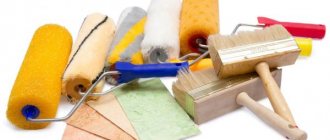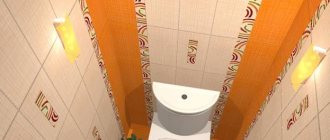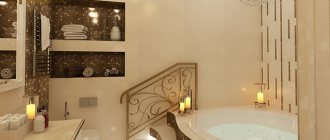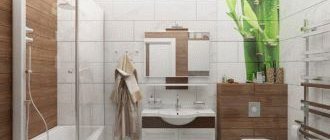Variety of tiles - choosing an option ↑
Toilet tiles can be of many different types. Shape, size, color, material – there are a great many finishing options!
The most practical type of finishing
Mosaic – a kaleidoscope of repairs ↑
Mosaic tiles have a number of advantages compared to classic tiles. And although the price of such pleasure is somewhat higher, the finishing result is worth it. Mosaics are produced on paper covering the front part, or on a mesh glued to the back of the plates.
Attention! Working with a mosaic placed on a grid is much more convenient than working with a version on paper.
When choosing a mosaic as a tile for a toilet, you should take into account that laying such material is quite complex and time-consuming. It requires certain skills and hard work. That's why this work costs much more.
Combined mosaic finishing
If you decide to lay the mosaic yourself, consider the following points:
- Mosaic tiles require special glue, since its remnants will in any case appear through the seams. Therefore, if the glue chosen is of insufficient quality, the appearance of the coating will be ruined.
- Mosaic tiles are supplied in sheets. It happens that on one of the sheets the mosaic elements are slightly smaller than on the others. It is better to set aside such a sheet for finishing inconspicuous areas or “for patches”. After all, during the repair process you will definitely come across broken elements that need to be replaced.
- Grouting of joints must be carried out very carefully and carefully, since in the future poorly processed joints will be difficult to clean from inevitable contaminants. It is best to choose a translucent grout that shades the color of the finish.
- It is better to lay the mosaic from top to bottom, securing the sheets with masking tape (protection against slipping).
- Under no circumstances should you press this type of finish with your hands! For styling, you can only use a polisher or a comb. Otherwise, waves and irregularities will form on the surface of the coating.
It is better to select one wall or a section of it for the mosaic. And if you want to add bright colors or rich colors to the interior, it is better to do this with the help of mosaic tiles. Indeed, thanks to its fractional structure, it prevents the feeling of space overload.
Different types of mosaics
Main types of mosaics:
- glass;
- stone (needs additional treatment to prevent dirt absorption);
- ceramic;
- smalt.
Metlakh tiles - the magic of shape ↑
The unusual shape of the tiles allows you to visually expand the space of the room, making it more spacious. Metlakh tiles often resemble a luxurious carpet, but they are also a little more difficult to install than rectangular tiles. Each row of tiles must be leveled using a rule (a long, even strip of aluminum or wood).
Advice! The smaller the toilet tile, the thinner the layer of adhesive on which it is laid should be.
When laying tiles in a toilet, it is important to consider whether the surface of this coating is glazed or not. Unglazed Metlakh tiles must be impregnated with a special compound that repels water and dirt.
Metlakh tiles give the room an oriental flavor
Ceramic tiles are a timeless classic ↑
Classic ceramic tiles can be different; the most popular types today are:
- porcelain stoneware - characterized by increased strength, imitate various structures, including stone and wood, it is used mainly for finishing floors;
- clinker tiles are abrasion-resistant and vapor-tight, imitating different surfaces, including brickwork.
Wood-look porcelain tiles
Ceramic tiles can be glazed or unglazed. Depending on the purpose (floor or wall cladding), its characteristics (thickness, density, etc.) change.
Clinker tiles go well with other types of finishes
Style for bathroom renovation
The design of the toilet should be harmoniously combined with the design of the entire apartment. If you have a separate bathroom, you should choose the same style for the bathroom and toilet.
USEFUL INFORMATION: For proper air exchange in the bathroom you need an exhaust fan with a timer
Toilet design ideas:
- Scandinavian style. This direction involves the use of white for the walls, a large amount of lighting (natural is best), and elements of wood trim. Using this direction in a small room will visually expand it.
- Palace style. Baroque and Rococo involve the use of gilded details, rich decoration, elaborate lamps and many decorative elements.
- High tech. This style is characterized by the use of the most modern materials, minimalism in decoration, and the predominance of black and white colors.
- Japanese. This style involves minimalism in all details, the use of simple forms. The walls can be decorated with tiles with the image of sakura.
There are many design options for bathrooms and toilet rooms. You can stick to certain trends or combine several styles. Your imagination should not be limited by anything, including materials.
Tile layout diagrams ↑
There are many answers to the question of how to lay tiles in a toilet. There are a huge number of tile layout schemes! After all, you can combine two, three or even more types of tiles, for example, making miniature contrasting inclusions among large elements.
For those who make repairs themselves, it is better to pay attention to simple installation methods.
Advice! To ensure that the straight layout of the tiles does not look “rustic”, one-sided cuts should be avoided. You need to start laying from the center of the wall and, if necessary, trim the tiles on both sides.
Selection of materials
The main requirement for all materials is hygiene. The toilet should always be clean, and it is advisable that cleaning does not take much time. That is why tiles are most often used to decorate walls and floors. It is easy to clean, is not susceptible to moisture and looks aesthetically pleasing.
There are several types of toilet tiles:
- Glazed tiles are the most popular type of wall decoration. There are many tile design options to suit every taste and budget.
- Regular ceramic tiles. It is thicker than tile and has a rough surface. Therefore, such tiles are most often placed on the floor in rooms with high humidity.
- Porcelain. These are glossy tiles, durable, less porous than ceramic, excellent moisture tolerance, and resistant to scratches and wear.
- Majolica is an incredibly beautiful expensive Italian tile with a relief surface.
- Porcelain tiles are durable, resistant to any impact, and easy to maintain. It can be matte, polished, satin, glazed, textured, providing wide design possibilities.
USEFUL INFORMATION: Everything about installing a wall-hung toilet with your own hands: toilet height, price (video)
Repairs to the toilet can be carried out using other materials:
- wallpaper;
- plastic panels;
- dye.
But all of the listed types of finishes are inferior to tiles in terms of hygiene and resistance to moisture. In addition, variations in colors, patterns and textures of tiles exceed the design capabilities of other materials.
When choosing a color, remember that a small toilet will be visually expanded by light tiles.
Five most common mistakes when laying tiles ↑
Finishing a toilet with tiles done by yourself is often accompanied by annoying mistakes. They can only be noticed at the end of the facing work, when it is no longer possible to correct the defects. So, the TOP 5 most common mistakes when laying tiles:
- Vertical arrangement of tiles. A separate toilet is often a small, narrow room. The vertical installation method additionally narrows and visually stretches the room, making it look like a pipe. It is uncomfortable to be in such a bathroom. And, although the horizontal placement of the tiles requires more skill (you will have to trim part of the tile), the end result looks much better.
- Selecting small tiles for the entire area of the room. An excessive number of small details in a small area leads to overload of space and causes a feeling of ripples in the eyes. The best option is large tiles or a combination of small and large elements.
- The joints between the tiles are too wide. The wider the seam, the easier it is to lay the tiles. But the ease of installation in this case is completely offset by the untidy appearance of the room. The optimal seam width when laying is 1.5–2 mm. However, with such a layout, you should be very careful about maintaining right angles and parallels.
- Seamless styling. The absence of gaps between individual elements of the coating can lead to “squeezing out” and cracking of the tiles. The reason here is the shrinkage of the walls of the house, which does not stop even decades after construction.
- Refusal to level the walls before laying tiles. Even an unevenness of 2 mm will immediately affect the quality of the finish. At the same time, horizontal curvature is not as striking as vertical differences.
A smooth wall is the key to success
How to combine different types of tiles - the best layout methods ↑
The correct layout allows you to visually increase the space and make the room more comfortable. Favorite design techniques for working with a small area:
- a combination of diagonal layout on the floor and horizontal tiles on the walls;
- deepening the space by transitioning the finishing from the floor to one of the walls;
- a bright accent on one of the walls of the room (a color spot or a mosaic panel);
- contrasting contours (a border, panel or separate area is highlighted in a contrasting color, which gives the room structure);
- horizontal waves (a combination of different colors that are in harmony with each other, distracts attention from the small size of the room);
- mirror wall (mosaic with a mirror surface reflects light well, adding volume to the room);
- play of light (soft lighting of walls, niches visually makes the room larger).
Advice! If the toilet has a small window, you can use the duplication technique using a mirror. To do this, a mirror of the same size as the window opening should be placed close to the window on the adjacent wall.
Toilet tile design
The color and design of the tiles play a big role. Beautiful tiles in the toilet create a general atmosphere and can hide some of the mistakes made when installing it yourself by a non-professional.
Dark or black tiles in the toilet look expensive and stylish, but are used only if the bathroom area is large enough. In addition, this color requires good lighting.
If you still like dark shades, but the bathroom does not have a large area, then as a compromise solution, you can lay one wall or just the floor of the toilet with black tiles.
Tiles for a small toilet should ideally be light in color. White tiles in the toilet will visually make the space larger and warmer.
Bright interior in a marine style
It is better to use tiles with geometric patterns for wall decoration, since on the floor such material can greatly emphasize the unevenness of the surface.
There are many options for laying colored tiles in the toilet. They allow you to solve problems posed during repairs. For example, vertical decorative decoration visually raises the ceiling, while horizontal decoration expands the room. Layering tiles from one shade to another can also significantly increase the space of the bathroom.
Original design in the toilet
Laying tiles is a complex and time-consuming process. Before you start bringing your ideas to life, it is worth studying in detail the technology of laying ceramic tiles and tiles on the floor and walls. But don’t hesitate - after familiarizing yourself with all the stages of work and using our tips, you will be able to lay tiles in the toilet with your own hands.
Fashion trends and current ideas ↑
Toilet tiles can and should be fashionable. Moreover, if the combination of its different types is chosen correctly, your “room of thoughtfulness” will be “in trend” for many years to come!
Elegant gray – impeccable style in every millimeter ↑
Do you associate gray with inconspicuousness and inexpressiveness? It's time to break this stereotype, since the classic shades of this color are the fashion trend of the coming season!
Steel and silver in the interior
Delicate ash, rich anthracite or a romantic shade of river mother-of-pearl - the variety of gray is truly impressive. It can be combined with many colors to create radically different looks. So ash pink will give the interior a vintage look, bright yellow will make the room more stylish, and coffee will bring a feeling of warmth and comfort.
Photos of finishing a toilet with tiles in gray shades impress with their sophistication and invariably reveal the delicate taste of the author of the design.
The struggle of contrasts - strict monochrome in the interior ↑
The combination of black and white can be different, because these contrasting colors have a lot of different shades. Frost color, milky, white wood shade - there are more than 40 variations!
You can also combine black and white in different ways:
- according to the principle of equality - each color is allocated a separate zone (wall, floor, niche);
- mixture of colors - shades of black and white form a peculiar pattern on one of the surfaces.
There are several rules for laying contrasting tiles in the toilet:
- An equal distribution of monochrome shades is suitable for rooms whose interior is designed in a simple style. Such a room should have a minimum of decor, a lot of clear, straight lines and ascetic accessories.
- A black and white pattern allows you to add a third color (for example, shades of wood), creating a more romantic look. Such a room can be decorated in Provence style or eco-style.











